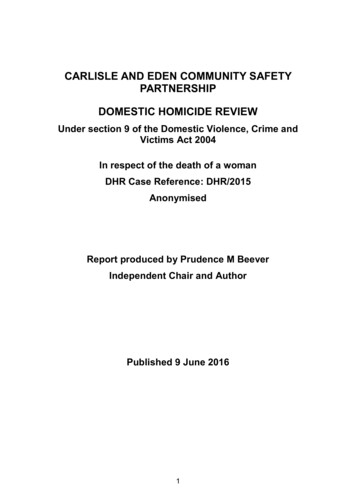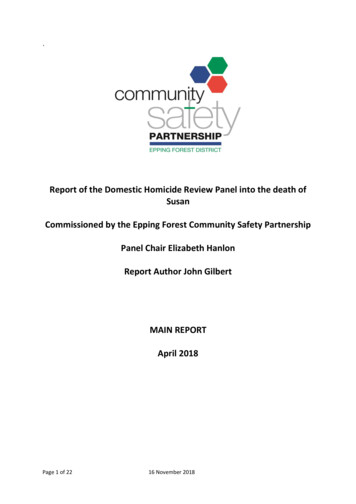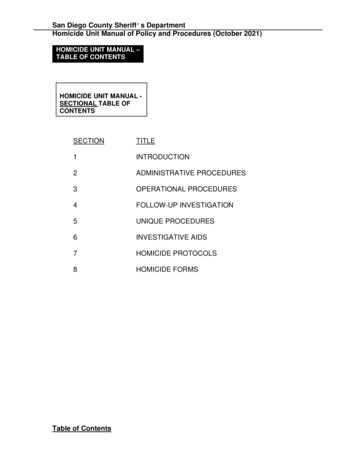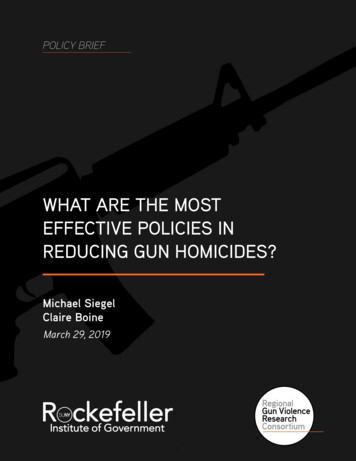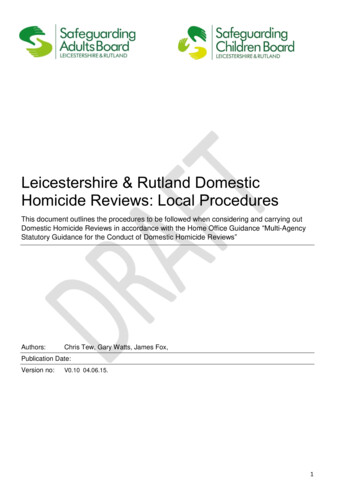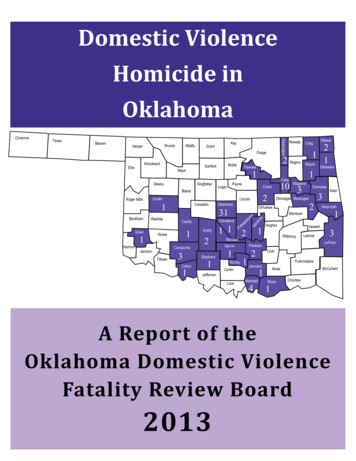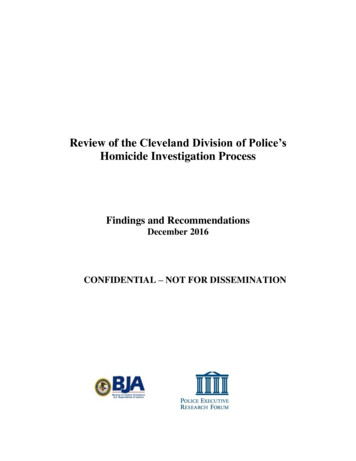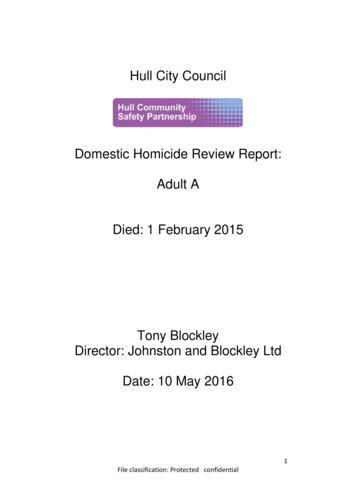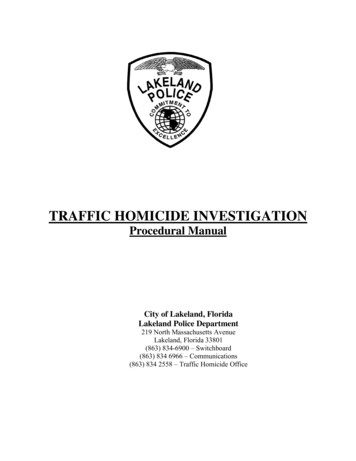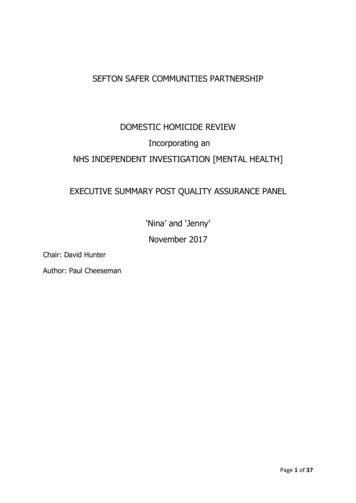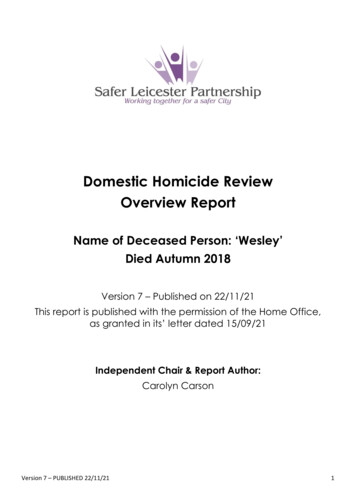
Transcription
Domestic Homicide ReviewOverview ReportName of Deceased Person: ‘Wesley’Died Autumn 2018Version 7 – Published on 22/11/21This report is published with the permission of the Home Office,as granted in its’ letter dated 15/09/21Independent Chair & Report Author:Carolyn CarsonVersion 7 – PUBLISHED 22/11/211
When asked if she would like to contribute a tribute to the victim and her deceasedhusband, Wesley’s estranged wife Cathy, chose instead to offer these words as a tribute toLeon, her son (the perpetrator):Leon is a lovely boy with a heart of gold.He wouldn’t want to see anyone in distress and would rush to help people always.Leon would think nothing of putting himself in danger for someone else.He truly cares for the feelings of his family and friends.Version 7 – PUBLISHED 22/11/212
ContentsPage1Introduction and Methodology32Involvement of Family and Wider Community53Contributors to the Review54Equality and Diversity85.Background Information86.Chronological Agency Interactions Prior to Scoping Period107.Key Practice Episodes:11 Interaction with Agencies 2016 – 2018Escalation of Relationship Issues and Offending Behaviour 2018Fatal Incident1112138.The voice of Wesley’s family149.Analysis by theme:Opportunities for Early Intervention by Agencies1717 Identifying Risks Through AdolescenceIdentification and Management of RiskBarriers to Effective Risk Identification and Reduction22273410.Conclusions3911.Lessons learned4012.Good Practice4113.Developments since the Review4214.Recommendations43Appendices1Terms of Reference and Project Plan452Single Agency Recommendations503Outline of commissioned domestic abuse services in Leicester City524Listen Up Research Equality Diversity and Inclusion: Learningconsiderations for DHR605Glossary70Version 7 – PUBLISHED 22/11/213
1Introduction1.1Domestic Homicide Reviews (DHRs) were established on a statutory basis under theDomestic Violence, Crime and Victims Act 2004.The purposes of a DHR are to:a) establish what lessons are to be learned from the domestic homicideregarding the way in which local professionals and organisations workindividually and together to safeguard victims;b) identify clearly what those lessons are both within and between agencies,how and within what timescales they will be acted on, and what isexpected to change as a result;c) apply these lessons to service responses including changes to informnational and local policies and procedures as appropriate;d) prevent domestic violence and homicide and improve service responses forall domestic violence and abuse victims and their children by developing aco-ordinated multi-agency approach to ensure that domestic abuse isidentified and responded to effectively at the earliest opportunity;e) contribute to a better understanding of the nature of domestic violenceand abuse; andf) highlight good practice.DHRs are not inquiries into how the victim died or into who is culpable; that is amatter for coroners and criminal courts, respectively, to determine as appropriate.DHRs are not specifically part of any disciplinary inquiry or process.Part of the rationale for the review is to ensure that agencies are respondingappropriately to victims of domestic abuse by offering and putting in placeappropriate support mechanisms, procedures, resources and interventions with anaim to avoid future incidents of domestic homicide and violence. The review alsoassesses whether agencies have sufficient and robust procedures and protocols inplace which were understood and adhered to by their staff.1.2The Review Chair, Review Author and domestic homicide review panel send theircondolences to Wesley’s family.1.3The report will examine agency involvement but will also examine the past toidentify any relevant background, or trail of abuse, before the homicide. It will alsoexamine whether support was accessed within the community and/or if therewere any barriers to accessing support. By taking a holistic approach, the reviewseeks to identify if there are appropriate solutions to make the future safer.1.4The brief circumstances of this domestic homicide are that Wesley had a violentargument with his adult son, Leon, which escalated to include injuries inflicted byknives used by both parties, but from which, sadly, Wesley died. Leon was foundguilty of Manslaughter on the 17th of April 2019 and subsequently sentenced to 10years imprisonment. The trial Judge assessed Leon as having reached theVersion 7 – PUBLISHED 22/11/214
threshold for ‘dangerousness’1, which necessitates a requirement to serve twothirds of his prison sentence before being considered for release.1.5The key purpose for undertaking DHRs is to enable lessons to be learned fromhomicides where a person is killed as a result of domestic violence and abuse. Inorder for these lessons to be learned as widely and thoroughly as possible,professionals need to be able to understand fully what happened in eachhomicide, and most importantly, what needs to change in order to reduce the riskof such tragedies happening in the future. This review is seeking to examine therole of agencies who came into contact with the victim, Wesley, his wife, Cathy,and his two sons, Leon and Wayne, to establish if there are any lessons to belearned as a result of engagement with the family or to identify missedopportunities for agency engagement. The review also seeks to understand thefamily’s ability to be aware of, and access, services they may have needed.1.6At the time of the fatal incident, Wesley was 42 years old and Leon, 18. The familyare of British Jamaican heritage.1.7TimescalesThis review commenced on the 26th of February 2019 and concluded on the 9thNovember 2020. There has been an extended delay in completing this review.Initially, Leon’s criminal trial was not heard until April 2019. Additionally, there hasbeen a further delay due to the involvement of different local authorities (Leicesterand Leicestershire) and multiple services, adding to the complexity of identifyingresponsibility for reports, consistent panel membership and appropriate level ofoversight, especially for Education services. The Safer Leicester Partnership shouldreview this situation for future safeguarding reviews.1.8ConfidentialityThe findings of each review are confidential. Information is available only toparticipating professionals and their line managers. To ensure confidentiality, thevictim of the homicide subject to this review is referred to as Wesley, and his son,who killed him, as Leon. Wesley’s wife is referred to as Cathy and their other childas Wayne. The pseudonyms were chosen by Wesley’s wife.1.9Terms of referenceThe detailed terms of reference and Project Plan appear at Appendix 1 whichdetails the purpose, framework, agency reports to be commissioned and theparticular areas for consideration for this review. For effective learning, it wasagreed that the scoping period for this review will be from the 23rd May 2016 untilthe date of death. There are however, incidents that occurred in the past, prior tothe review period, that have significance and these will also be included wherethey provide learning.1.10MethodologyThe Review sub-group of the Safer Leicester Partnership recommended thecircumstances of this case as fulfilling the criteria for a statutory domestic homicidereview and this was approved by the Chair of the Safer Leicester Partnership. TheSerious Incident Learning Process (SILP) model of review was commissioned to beused within the domestic homicide review process.1.11SILP is a learning model, tried and tested in safeguarding reviews for bothchildren’s and adult’s cases, including domestic homicide reviews, and takesaccount of principles enshrined in government guidance. The process seeks to1 A category of court assessment for specified sexual and violent offences, known as “dangerousness” t/uploads/system/uploads/attachment ion 7 – PUBLISHED 22/11/215
engage front line staff and their managers in reviewing cases to focus on whythose involved acted in a certain way at the time.1.12An initial scoping meeting and first panel meeting was held on the 26th February2019, where agency representation, terms of reference, the scoping period andthe project plan were agreed. This was followed by a full days learning event onthe 10th June 2019.1.13Whilst applying the principles of the SILP methodology, the independent chair andauthor have followed the Multi-Agency Statutory Guidance for the Conduct ofDomestic Homicide Reviews, as amended in December 2016. Importantly, themodel has incorporated 4 review panel meetings, a sufficient number of meetingsin this case for the panel to effectively support the review and to discharge theirduties.1.14Parallel ReviewsThere have been two parallel reviews, namely the police criminal investigation andthe Coroner’s Inquest. Both have been updated concerning this review, and inparticular, the Senior Investigating Officer (SIO) of the criminal investigation had fullsight of all issues relating to Disclosure and provided advice in relation to theinterviewing of potential witnesses in advance of the trial date.2Involvement of Family and Wider Community.2.1Cathy has been supported through this review process by Advocacy After FatalDomestic Abuse (AAFDA). She has been kept updated through the process.2.2Cathy has very helpfully contributed to this review. She met with the Author at theinitial Panel stage. Her thoughts, views and opinions are threaded through thereport, where relevant. Cathy has had the opportunity to see a copy of the finaldraft report. Her feedback corrected some details and acknowledged thecomplexity of the family dynamics and the review’s success in representing them.2.3Both Leon and Wayne have been offered opportunities to engage directly withthe review. Cathy was the main family contact and represented all of the family’sviews. Due to not being able to state exactly who was residing in the family homeat various points through the review period, it was not felt proportionate toapproach wider family members, directly without Cathy’s consent.3Contributors to the Review3.1Contributors to the Review:AgencyContribution Individual Management Review (IMR), Provided byLeicestershire Policean Independent Review Officer. Attended Learning and Recall EventCrown Prosecution Service – EastMidlands Individual Management Report (IMR), provided byan Independent ManagerLeicester City Council Children’sService IMR provided from an Independent ServiceManager. Attended Learning and Recall EventGeneral Practitioner Summary Report provided by an IndependentReview Officer.Leicestershire Partnership TrustVersion 7 – PUBLISHED 22/11/21 IMR provided from an Independent SafeguardingLead. Attended Learning and Recall Event6
3.2Leicester City Council –Community Safety Team Manager, Domestic and Sexual ViolenceTeam.Leicester City Council – Domestic& Sexual Violence Team Administered process. Provided advice andguidanceClinical Commissioning Group Attended Learning and RecallYouth Offending Team IMR provided from an Independent SafeguardingLead.Attended Learning and Recall EventUnited Against Violence andAbuse (UAVA) Attended Learning EventLeicestershire County Council –Education IMR provided from an Independent SafeguardingLead.Leicester City Council Education IMR provided from an Independent SafeguardingLead. Attended panel meetingLeicester City Council HousingTeam IMR provided from an Independent SafeguardingLead. Attended Learning Event and Recall Event.Primary School 1 Report provided from an IndependentSafeguarding Lead.Secondary School 2 Report provided from an IndependentSafeguarding Lead.Secondary School 3 Report provided from an IndependentSafeguarding Lead.Secondary School 4 Report provided from an IndependentSafeguarding LeadThe Review Panel members Donna Ohdedar - Independent Chair, Review Consulting. Attended andChaired the Learning Event. Carolyn Carson - Independent Author, Review Consulting. Also acted as Chairfor all panel meetings except the Learning Event. Claire Weddle – Service Manager, FreeVA - Free from Violence and Abuse andmember of the UAVA consortium Siobhan Barber – Detective Inspector, Serious Crime Partnership Manager,Leicestershire Police Lesley Booth – Service Manager, Leicester City Council Children’s Social care Karen Manville – Service Manager, Leicester City Council, Children & YoungPeople’s Justice Service Sarah Morris – Head of Service (Social Work), Leicester City Council, Adult SocialCare Brendan Seward – Service Manager, Leicester City Council, Children’s Social care Nick Griffiths – District Manager Leicester City Council, Housing Julie Quincey – Acting Trust Lead for Safeguarding, Leicestershire Partnership NHSTrust Stephanie McBurney – Domestic & Sexual Violence Team Manager, LeicesterCity Council Sophie Maltby – Team Leader (Social, Emotional and Mental Health), LeicesterCity Council, Social Care & Education Bhavin Pathak – Mental Health Manager, Psychology Service, Leicester CityCouncilVersion 7 – PUBLISHED 22/11/217
Rachel Garton – Designated Nurse, Safeguarding Adults and Children, LLR HostedSafeguarding Team3.2.1The process has been administered and supported by officers within the Domesticand Sexual Violence Team of Leicester City Council, on behalf of the SaferLeicester Partnership.3.3Report Chair and Author3.31The review commissioned Donna Ohdedar, to act as Independent Chair. Donna isan independent safeguarding consultant with no links to the Safer LeicesterPartnership or any of its partner agencies. Donna has 16 years’ public sectorexperience, including her last role as Head of Law for a leading metropolitanauthority. Now a safeguarding adviser and trainer, Donna is involved in seriouscase reviews in both Children’s and adults’ safeguarding, domestic homicidereviews and SILP.3.32The report has been authored by Carolyn Carson, an independent safeguardingreviewer. Carolyn also became the review Chair for all panel meetings except theLearning Event. Carolyn is a retired Police Superintendent who specialised inSafeguarding, retiring whilst holding the post of Safeguarding Lead at Her Majesty’sInspectorate of Constabulary (HMIC), in 2011. Post retirement from 2012, Carolynhas conducted adults safeguarding reviews, domestic homicide reviews and SILP,independently. Carolyn has been entirely independent of agencies in Leicestersince April 2010 when she joined HMIC.3.4Dissemination Family of WesleySafer Leicester Partnership ExecutiveLeicester Safeguarding Children Partnership BoardSafer Leicester Partnership websiteLocal Criminal Justice BoardLeicester, Leicestershire & Rutland Domestic and Sexual Violence andAbuse Operational GroupLeicestershire Police and Crime Commissioner4Equality and Diversity4.1The protected characteristics relevant to the family are: ethnicity (the familyidentifying as British Jamaican); the ages of the children, being adolescentsthrough the scoping period; disability for Wesley, with a diagnosis of Post-TraumaticStress Disorder; and disability for Wayne, with a diagnosis of Attention DeficitHyperactivity Disorder (ADHD). All agencies completed a specific equalitiesappendix via their IMR report.4.2To assist the panel to be better informed on issues relating to the protectedcharacteristics of race for the family, which were highlighted as of specific impactby Cathy, and to provide insights to greater learning going forwards, the reviewcommissioned an independent specialist, Jahnine Davis from ‘Listen Up Research,’to review and comment on the overview report when at draft stage in July 2020.Jahnine’s full report is available at Appendix 4. Whilst it is difficult for the review todraw conclusions on the insights against agency practice through the early scopeof the review, given the passage of time, the expertise provided in how agenciesmay better understand cultural competence has been incorporated to providelearning going forward. The review is very grateful for the specialist insights gainedfrom ‘Listen Up research’.Version 7 – PUBLISHED 22/11/218
4.3To support victims and seek to reduce barriers, there are a number of domesticabuse services available to victims and perpetrators in Leicester City throughoutthe scoping period and currently2.5Background Information5.1GENOGRAMCathy’sCathyAged 51Ex-partnerSon2DaughterSonWesley’sfirst wifeWesley (deceased)Aged 42 at deathWayneAged 16LeonAged 18SonDaughter5.2Wesley was born in Jamaica and moved to the UK in 1997, aged 21 years. Hemarried his first wife in 1997 with whom he had two children, born in 1998 and 2000respectively. The marriage broke down and Wesley formed a relationship withCathy, who became his wife until his death. They married in 2004 and had twochildren together, Leon born in 2000 and Wayne, born in 2002. Cathy has threeolder children born before she met Wesley, not subject to this review, but who livedwith the family on an extended basis at different times through the review. InSeptember 2013, whilst remaining married, Wesley formally moved out of the familyhome and he and Cathy lived separately, with separate tenancies. This was dueto Wesley not feeling safe in the area of the family home. However, they wereknown to still spend much time together in Cathy’s family home. From 2017, to hisdeath, Wesley was training to be a pastry chef at a local Further EducationCollege.5.3From September 2018, until his death, Wesley returned to live back in the familyhome with Cathy, and this is where the homicide occurred. Also living at theaddress at this time were Wayne and an unknown number of extended familymembers.5.4Leon returned to live with Cathy in mid-October 2018. Prior to this, he had beenmissing from the family home since the 25th July, having absconded whilst on bail.He returned on strict bail conditions to live at home subject to a nightly curfew andelectronic monitoring. The homicide occurred here two days later. During theevening of the homicide, Wesley had taken a phone call concerning Leon’salleged behaviour that angered him and this caused an argument betweenthem. Due to Leon’s consequent demeanour, Cathy called an ambulance, at9.22pm, believing him to be having a nervous breakdown. Leon calmed downand Cathy rang to cancel the ambulance at 9.45pm. However, at 10.15pm,Cathy called the police to report Wesley and Leon now fighting with knives.5.5The situation escalated and Wesley chased Leon to his bedroom whilst holding akitchen knife. Leon is now known to have taken cocaine at the time. In the smallbedroom, Leon reached for a combat style bladed knife with which he stabbedhis father several times, resulting in Wesley’s death. Leon was charged with MurderSee Appendix 3 for full outlineVersion 7 – PUBLISHED 22/11/219
and found guilty of Manslaughter on the 17th April 2019, and was sentenced on the2nd August 2019.5.6The Post-mortem revealed that Wesley had died from stab wounds. Severalsignificant injuries were noted, nine in total, including defensive injuries. The causeof death was attributed to a neck injury and upper chest injury which puncturedthe lung. There was a further significant wound to his rear right shoulder. The guiltyverdict of Manslaughter was accepted by the Coroners Officer as the cause ofdeath.5.7Leon is known to have had a poor relationship with his Father. Wesley was knownto be violent and domestic abuse existed in the family, perpetrated by Wesleythroughout the scoping period of the review. Cathy told the Chair/Author of thisabuse and its duration. It is important to note however, that Cathy did not formallyreported the abuse to agencies after 2007. At 15 years old, Leon was educatedoff site with a specialist provider, Triple Skillz, who attributed his reducedattendance to forming new peer groups and becoming involved in drug dealing.In hindsight, Leon has been identified as having been at risk of significant harm,both in the home through violence, and through criminal exploitation.6Chronological Agency Interaction Prior to the Scoping Period 2003 - 20166.1In 2003, Cathy first reported a domestic assault by Wesley. She subsequentlyreported three further assaults. In 2006, Wesley struck her to her head with a shoe,for which he received a conviction for assault. This incident was assessed to be astandard risk by police. A further domestic incident, witnessed by Leon andWayne, was reported in 2006, but no charges laid. In July 2007, Wesley againassaulted Cathy to the head. The risk assessment was raised to a medium risk bythe police. Cathy made no further formal reports to the police, employer, or otheragencies.6.2In 2006, Wesley was convicted of two drug possession offences.6.3In 2007, Wesley was the victim of a serious assault perpetrated by his brother-inlaw. Wesley, whilst under the influence of alcohol, sought to end a family party atthe family home, making threats with a knife and axe, before stabbing his brotherin-law. He was overpowered and received life-changing stab wounds. Thesetraumatic incidents were witnessed by Leon, then aged 7 and Wayne, aged 5, butthe Panel did not see evidence that these led to safeguarding referrals from EMASor the Police.6.4The crime report for the incident has been further reviewed by the Police’sRegional Review Unit. There is no record of any documents relating to any referralsfor the children to Children’s Social Care. That said, it should be noted thatLeicestershire Police moved to the new ‘Niche’ crime and intelligence recordingsystem in 2015 and records from the previous Crime & Intelligence system (CIS) hadto go through a process of back record conversion. There is the possibility that alldocumentation may not have been transferred onto Niche due to the complexityof the task.6.5Case Administration & Tracking System (CATS) was the main recording system inuse by the Leicestershire Police Children’s Referral Desk in 2007 and was aseparate system to CIS. The incident in question was dealt with by Serious/MajorCrime and recorded on CIS. In 2007, any incident involving or witnessed bychildren should have been forwarded to the Children’s Referral Desk via aVulnerable Child Report which was the attending officer’s responsibility togenerate by way of an email or task within the CIS system. However as stated,looking at the old report that has been converted on to the new system, there isno record that a vulnerable child report was generated and shared with Children’sSocial care.Version 7 – PUBLISHED 22/11/2110
6.6Since then, the process for recording incidents relating to domestic abuse andsafeguarding concerns has changed quite considerably. The changes mean thata referral to Children’s Social Care is more likely now, than it was in 2007. Thechanges are detailed further in Section 13 of this report.6.7Prior to 2008 EMAS utilised a different dispatch system to the one it uses now. Atthat time all records were on paper. With the information available it has not beenpossible to access the record for the 2007 event. However, given the time that haspassed since the incident and the significant changes EMAS has made since then,EMAS has been able to provide the Panel with some reassurance in that prior to2010 EMAS did not have a safeguarding team and safeguarding referrals andintervention within the organisation were limited. However, following a CQC visit in2010 the organisation invested in a safeguarding team and a full review of allsafeguarding requirements for the Trust. The Trust received another inspection andit was recognised that there had been a significant improvement in safeguardingand Domestic Abuse standards across the Trust, with a referral far more likely now.6.8As a consequence of being stabbed in 2007, Wesley suffered Post Traumatic StressDisorder (PTSD), requiring on-going treatment from a Community Psychiatrist fordiagnosed Post Traumatic Disorder and Recurrent Depressive Disorder. He wasprescribed Mirtazapine and Venlafaxine anti-depressants. Mental healthtreatment was not effective initially, partly due to Wesley not attendingappointments. It has been later established that he was reluctant to attendbecause the appointments were located close to where his brother-in-law lived.Wesley suffered mood swings which affected family life. Leon and Wayne told thehomicide investigation that Wesley was quick to violence and ‘heavy handed’ inhis behaviour. He would turn to knives to settle arguments.6.9Both Leon and Wayne attended primary school 1. Their attendance averaged inthe mid 80% range. Between 2005, when Leon was 5 and 2010, when 10 years old,in excess of 30 behavioural incidents were recorded for Leon but no exclusions. AnIndividual Education Plan (IEP), was put in place. A child protection referral wasmade in 2008 when Leon ,aged 8 years, disclosed that Wesley had hit him aroundthe head with a metal pole.6.10At primary school 1, Wayne exhibited challenging behaviour. In 2009, aged 7 and2010, aged 8, there are two incidents recorded where Wayne was observed tostrangle other pupils. Following the second occasion, school staff witnessed Cathythreatening to hit Wayne in front of everyone if he didn’t behave. He was subjectto three periods of exclusion and due to an escalating temper, School 1 referredWayne to Children and Adolescent Mental Health Services, (CAMHS), in May 2011.He was diagnosed with Attention Deficit Hyperactivity Disorder (ADHD), andprescribed medication. Wayne had several Individual Education Plans andbehavioural charts. He was referred to the School Nurse for anger management.6.11Leon had no involvement with Special Educational Needs or Disability professionalswhilst at primary school. At Secondary School 2, between March 2011 and April2014, 42 letters were sent to Leon’s parents as a result of his behaviours. One letteralone in 2014 outlined 138 behavioural incidents. He received one exclusion in2012. In February 2012, Leon was seen by an Educational Psychologist. He wasalso subject to School Action Plus in Years 8, 9 and 10. To prevent permanentexclusion, Leon transferred to Secondary School 3 in April 2014 ,where he wasinvolved in a total of 20 behavioural incidents. His attendance deteriorated and inSeptember 2015 he was subject to an Education Welfare Service panel meetingwhich resulted in him being educated off site with Triple Skillz.6.12In 2015, Wesley was convicted for making threatening calls to the police and forbeing in possession of an offensive weapon, (extendable baton). Separately inVersion 7 – PUBLISHED 22/11/2111
2015, he was convicted for failing to provide a specimen of breath for which hereceived a three-year driving ban.6.13Secondary School 1 have recorded incidences where both boys were noted tolive in a chaotic and disorganised environment. Several instances were noted forattending school without breakfast, P.E. kit or other equipment.6.14At Secondary School 2, between March 2013, aged 11, and July 2016, aged 14,Wayne was subject to in excess of 350 behavioural incidents and 21 behaviouralletters to his parents, and he was categorised as School Action Plus for social,emotional and behavioural difficulties.7Key Practice Episodes7.1Interaction with Agencies 2016 – 20177.1.1On the 23rd May 2016, East Midlands Ambulance (EMAS), responded to a report ofWayne in a park whilst incapacitated through substance misuse. EMAS made achild protection referral to Children’s Social Care, outlining their concerns about hispresentation, and their level of concern at having also received a report he maybe subject to domestic abuse as a result of his actions. A copy of the referral wasforwarded to Wayne’s GP and his School Nurse. At this time, Wayne was receivingon-going treatment from Children and Adolescent Mental Health Services(CAMHS), for diagnosed ADHD and medication management.7.1.2From January to June 2016, due to deteriorating attendance rates. Leon waseducated off-site with Triple Skillz,7.1.3On the 22nd July 2016, the police recorded their first intelligence report of Leoncarrying a knife. Further intelligence was recorded that on the 4th October 2016,Leon made threats whilst in possession of a golf club, although this was notsubstantiated.7.14In August 2016, Wayne transferred to Secondary School 4 for a fresh start. Hisbehaviour was described as disruptive and, between August and November 2016,he received 3 periods of exclusion totalling 4 days.7.1.5On the 29th September 2016, Cathy personally visited Children’s Social Care torequest help with Leon and Wayne’s behaviour.7.1.6On the 27th October 2016, Wayne was discharged from CAMHS service due tonon-attendance of appointments from July 2016. He was accepted back toCAMHS on the 30th June 2017 following a direct request from Cathy. In October2017 he was offered an appointment for a date in February 2018.7.1.7In September 2017, Leon transferred to College 1. In October 2017, he waswitnessed on CCTV to be suspected of drug dealing. College 1 also felt Leon hadan unacceptably low attendance rate, and he was excluded from college.7.1.8In October 2017, Wesley reported to police his fears that his wife’s family wanted todo him harm. In December 2017, he telephoned to speak to a GP because hehad stopped taking his medication and was ‘feeling strange’.7.2Escalation of Relationship Issues and Offending Behaviour 20187.2.1In January 2018, Wesley’s GP referred him for support with flash backs. Wesley alsoresumed his outpatient appointments with his Consultant Psychiatrist formedication reviews, but he was discharged in February 2018 due to nonattendance. Meanwhile, a decision was made that Wesley was more suitable for‘Open Mind3 services for flash backs, where, during an initial telephone3 OPEN MIND: ster-open-mind-service/Version 7 – PUBLISHED 22/11/2112
consultation on the 29th March, he
Domestic Homicide Reviews, as amended in December 2016. Importantly, the model has incorporated 4 review panel meetings, a sufficient number of meetings in this case for the panel to effectively support the review and to discharge their duties. 1.14 Parallel Reviews There have been two parallel reviews, namely the police criminal investigation and
